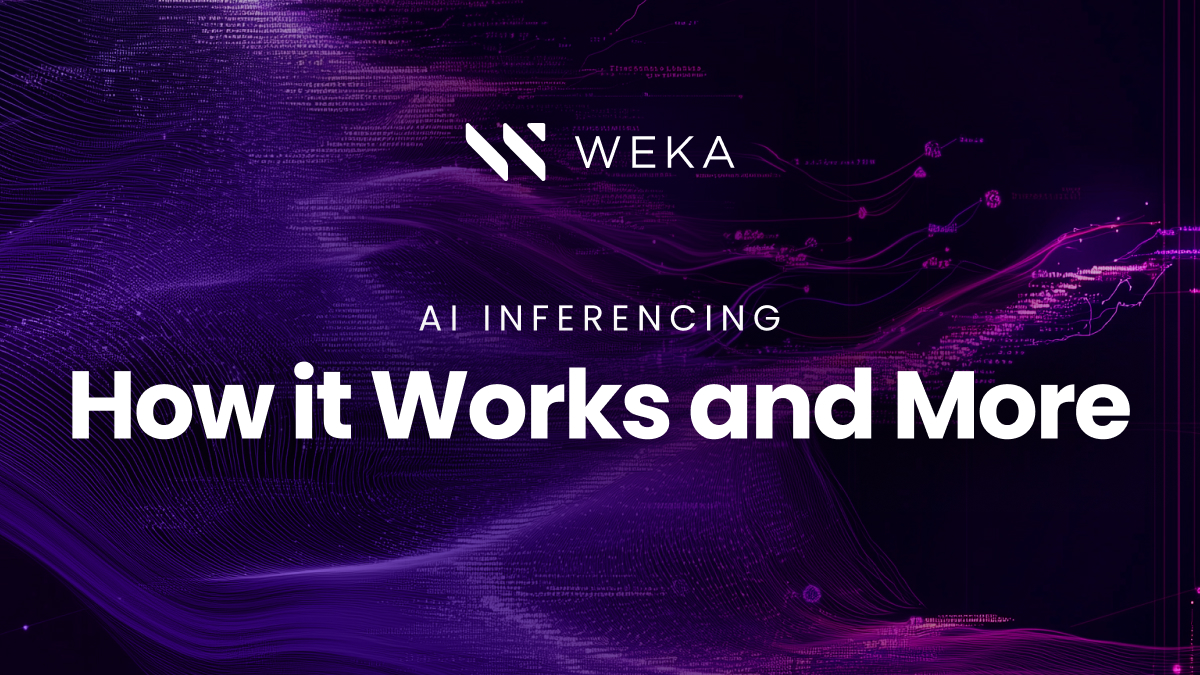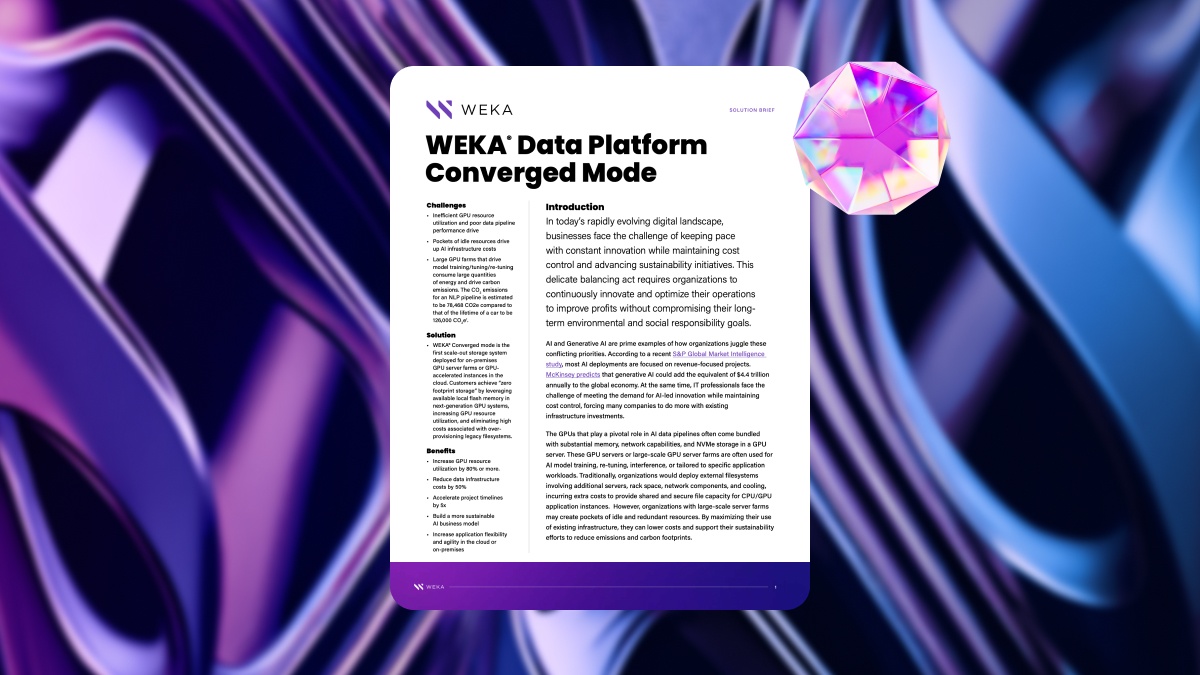AI Inferencing: How it Works and More

What is AI Inferencing?
What is inferencing in AI? Inferencing in AI is the use of a model to analyze new data to make predictions. In the field of artificial intelligence (AI), the inference process allows a trained machine learning model to draw conclusions from brand-new data without examples of the desired result.
Inferencing in AI is done from inference engines—software components of AI systems that apply logical rules to their knowledge bases to deduce new information. Inferencing meaning in AI includes considering background information, asking questions, making predictions, and drawing conclusions.
How Does AI Inferencing Work
How does AI inference work? Inferencing AI systems use the knowledge from their training on large data sets to develop their intelligence, analyze new data, recognize patterns in it, and make predictions. For example, AI inferencing can:
- Help self-driving cars recognize traffic signs they have already learned to “see” in new contexts (such as driving on new routes)
- Predict the future performance of a professional sports player based on their past performance
- Interpret medical images based on available expertise worldwide—even when local experts lack the specific expertise needed to make certain conclusions
A model that was well-trained on quality data can draw these kinds of conclusions with a powerful inference engine in real time.
Generative AI Inferencing Explained
Predictive AI inferencing makes informed guesses about outcomes based on patterns it finds in existing data. Examples of this kind of AI inferencing include web search engines and recommendation engines from streaming services and e-commerce sites.
Generative AI inferencing models use deep learning and neural networks to identify structures and patterns in existing data to generate new and original content. Generative AI inferencing takes predictive AI inferencing one step further by actually creating new data (such as text or images in response to queries or prompts.
Inferencing in generative AI can also be used to write code or music, and even design structures, pharmaceutical compounds, and molecules.
Importance of AI Inference
Why is AI inferencing important? AI inferencing meaning goes far beyond merely learning on new datasets. The importance of AI inferencing centers on the fact that the process allows machines to learn without much human guidance or input and generate unique insights.
Practically, AI inferencing enables AI systems to master real-world activities, such as interpreting medical imaging to diagnose diseases, parsing web traffic and data to identify fraud, and engaging with consumers to improve customer experiences.
This allows businesses to make faster decisions, automate processes, and provide AI-powered services. Deploying AI model inferencing in edge data centers can protect privacy more effectively, retaining sensitive data on the device. And improving inference AI efficiency can reduce the environmental impact of AI technologies.
Types of AI Inference
What are some different types of AI inference? We have already discussed predictive and generative AI inferencing, but there are several other types of AI inferencing—each is a bit different:
- Batch AI inference. Batch or offline inferencing is optimal for machine learning on large data sets. It is the process of generating insights into a batch of observations, typically on a recurring schedule (such as hourly or daily).
- Real-time AI inferencing. Online or real-time, it processes data as it is received and delivers immediate predictions. This type of inference is crucial for applications such as autonomous driving.
- Edge AI inference. Edge AI inferencing uses models on local devices to analyze data and make decisions, rather than relying on cloud servers.
- Probabilistic AI inferencing. Probabilistic or statistical inference calculates the likelihood of a variable having a certain value based on other variables in a probabilistic model. It’s often used in decision-making systems such as weather forecasting. Probabilistic AI inferencing can help AI systems make informed decisions, understand complex situations, learn, and process data in new scenarios without direct instructions.
- Rule-based AI inference. Rules-based or semantic AI inferencing uses a set of predefined rules to process data and make decisions. Developers create a list of rules and facts for the AI system which follows the rules to measure the information provided and perform the programmed functions. Rule-based AI inferencing is useful in finance, medicine, or industrial domains, where decisions can be codified into rules. For example, a medical diagnostic system might use this rule: “If the patient presents with a fever and a rash, especially a petechial rash, rule out serious infections like meningococcemia.
- Natural language processing (NLP) AI inferencing. NLP AI inference involves recognizing and generating human language. For example, a language translation app translates from one language to another in real time.
Which phases are part of inferencing an AI model, and is this the same for all types of AI inference? In general, the AI inferencing phases of a model are:
- Weight application/forward pass. The model applies the weights it learned during training to the input data.
- Computation. The model arrives at results based on its learned weights and architecture.
- Output generation. The model produces an output—such as a prediction, a classification, or generated content—based on its computations.
- Post-processing/delivery. The model refines its raw output to make it more actionable or more easily interpretable, and delivers its final output to the user or system that requested it.
AI Inferencing vs Training
How does training vs inferencing AI differ? The main difference between AI training vs inferencing is that training an AI model teaches it how to perform a task, while during AI inferencing, the model uses its training to make predictions.
During the AI training phase, the AI model learns how to perform a task by consuming large amounts of training data. The model learns to recognize patterns, make predictions, and execute specific tasks. Training can be a one-time task or an ongoing process.
AI inferencing is the phase where the trained model uses its knowledge to analyze new data and make predictions or classifications. Inference is ongoing, and the model is constantly applying its training to new data.
Another difference between training and inference is their impact on infrastructure. AI training requires a lot of storage capacity to store the large datasets the learning model uses for training. AI inferencing strains computational resources less, but it demands low latency and high throughput for real-time processing.
If you’ve ever watched a show like The Great British Baking Show, you already understand the difference between training and inference. You may have watched these experienced bakers and wondered how they can achieve so much with so little input.
Highly skilled bakers like that are analogous to well-trained AI models; they are ready to draw inferences based on what they already know, and use that information to generate new outputs.
AI training is like a student learning to bake. You start by gathering many recipes, learning to execute them, experimenting with ingredients, and practicing your techniques until you understand how to bake many different things very well. This process involves a lot of trial and error and takes time to feel intuitive—similar to how AI training involves processing huge datasets, adjusting parameters, and recognizing patterns.
AI inferencing is only possible for models with sufficient training—just like that kind of baking is only possible for highly skilled cooks. It’s like knowing how to create a certain kind of confection with just a basic set of directions once you already know about how to make that kind of thing (and many other dishes like it).
It’s similar to the reason a contestant on the show, for example, can glance at a bare bones list of ingredients and say, “This is a laminated dough, which means I need to use cold butter, fold and chill the dough multiple times, and that I don’t need any other leavening agent.” AI inferencing uses the patterns and knowledge acquired during training to produce quick results—just like a trained baker can now create dishes efficiently without reinventing the process each time.
Applications and Uses
There are a number of important applications and uses of AI inferencing in multiple verticals:
Computer Vision
- Image and video analysis. AI inferencing is used for object detection, facial recognition, and scene recognition in healthcare, retail, cybersecurity, and autonomous driving applications.
- Medical image analysis. In healthcare, it can help analyze CT scans, MRIs, and X-rays to diagnose diseases, detect tumors, and otherwise extract important medical insights from images.
- Augmented and virtual reality. Real-time AI inference creates immersive AR and VR experiences by interpreting and adapting to the user’s environment.
Natural language processing (NLP)
- Chatbots and virtual assistants. Models understand and respond conversationally to user queries in the context of personal assistant, customer service, and educational applications.
- Sentiment analysis. Businesses analyze customer feedback and social media for sentiment to understand public perception.
- Machine translation. Models such as Google Translate use AI inferencing to translate languages in real-time.
Autonomous vehicles and robotics
- Self-driving vehicles. It can help analyze data from cameras, sensors, and radar to predict pedestrian movements, recognize objects, and make driving decisions.
- Industrial robots. In manufacturing, robots perform precise tasks such as assembly, packaging, and quality control to analyze visual and sensory data.
Finance and banking
- Fraud detection. AI inference models analyze transaction patterns in real time to detect fraudulent activities.
- Credit scoring. Banks use AI inferencing to assess credit risk by analyzing historical loan performance and applicant data.
- Algorithmic trading. It can help analyze market data in real time to make decisions and buying and selling to maximize returns based on signals and patterns.
Retail, industry and e-commerce
- Personalized recommendations. AI inference models suggest products based on customer preferences and behavior, enhancing user experience.
- Inventory optimization. By predicting demand, it can help manage stock, reduces waste, and ensures items are available.
- Dynamic pricing. It assists in analyzing factors like competition, demand, and seasonality to adjust prices, helping users stay competitive.
- Predictive maintenance. It is used to predict equipment failures in industries like aviation, manufacturing, and energy based on sensor data and historical performance, reducing maintenance costs and downtime.
Healthcare
- Predictive diagnosis. AI inference can analyze patient data to identify disease risks and recommend preventive care.
- Drug discovery. AI models analyze experimental and trial data to predict optimally effective compounds, speeding the drug development process.
- Electronic health records (EHR) analysis. AI inferencing can extract insights from EHRs, identifying potential health risks for individual patients and larger trends.
Energy and agriculture
- Grid optimization. Models predict electricity supply and demand to balance the grid and reduce waste.
- Renewable energy forecasting. It predicts the output of renewable energy sources like solar and wind based on weather conditions.
- Crop monitoring. It analyzes imagery from satellites and drones to predict yields, monitor crop health, and detect pests or diseases.
- Precision agriculture. Its models make real-time decisions about fertilization, water use, and pesticide application based on weather and soil data, optimizing crop production.
Cybersecurity
- Threat detection. AI inference models analyze network activity in real time to identify patterns that suggest cyber threats or attacks.
- Behavioral analysis. It can flag unusual behavior to detect insider threats or unusual user account activity.
Challenges of AI Inferencing
Some of the main challenges of AI inferencing include:
- Intensive computing demands, scaling, and cost. AI inferencing is compute intensive, requiring significant computational power, especially when it involves bigger, more complex models. This can produce latency issues in real-time applications, trigger high operational costs, and demand specialized hardware to effectively manage processing demands.
- Data privacy. Systems use large amounts of data, including sensitive information, which must be protected.
- Latency. Low-latency AI inference is necessary for real-time applications, and this can be a challenge to achieve.
- Bias. Its systems have the potential to be biased based on the data they are trained on.
- Transparency. It can be difficult to understand how AI systems reach their decisions and maintain quality control as a result.
- Environmental impact. It consumes large amounts of energy, which can increase carbon emissions.
- Model explainability. Complex deep learning models and their AI inference decisions can be difficult to interpret.
- Hardware constraints. Current AI models may lack sufficient VRAM for LLMs’ large size and complexity.
- Data preparation. Due to the growing range of data types and differences in quality, data preparation can be challenging.
WEKA and A Inferencing
The WEKA® Data Platform revolutionizes AI inferencing by delivering ultra-low latency and high throughput, ensuring real-time responsiveness for time-sensitive applications. Its advanced kernel bypass technology eliminates the overhead of traditional storage systems, enabling direct, high-speed communication between the network, storage software, and NVMe devices. This capability ensures rapid data access and consistent performance, even under the high demand of inferencing workloads. For industries relying on real-time AI, such as autonomous vehicles, financial services, and healthcare, WEKA’s architecture minimizes delays and maximizes the efficiency of NVIDIA GPUs, empowering models to deliver fast, accurate predictions.
In addition to low latency, WEKA optimizes storage for metadata-intensive inferencing operations, addressing bottlenecks common in legacy systems. Its distributed metadata management eliminates performance hotspots by spreading metadata responsibilities across the entire cluster, ensuring seamless scalability and consistent performance at scale. With its ability to saturate high-bandwidth links and handle millions of IOPS, WEKA supports applications like retrieval-augmented generation (RAG) and vector database queries. By enhancing data accessibility and streamlining inferencing workflows, WEKA accelerates insights and reduces operational costs, making it an ideal solution for modern AI infrastructures.





